When it comes to guitars with a semi hollow body vs hollow body, there are some significant differences in size, style, and sound! I’m often asked how one type compares to the other. The most crucial difference is that semi-hollow body guitars are thinner, with a central wooden block separating two hollow chambers. In comparison, hollow body guitars are usually thicker and completely hollow.
Keep reading to learn everything that matters, starting with the short answer.
You can use the table of contents below to take you to the area that interests you. Click on the little box to open it, and then click on the section of the article you want to read, or you can read from start to finish if you want the whole learning experience!
The Short Answer
Semi-hollow body guitars are thinner and hollow on both sides with a wooden block down the center, which gives the guitar structural stability with a more balanced sound preferred by some Jazz, Rock, Blues, and Pop players. Hollow body guitars are usually thicker and completely hollow, which gives the guitar a mellow and bassy sound preferred by most Jazz players.
Keep On Reading (Below) To Learn More
Semi-Hollow Vs. Hollow – The Main Differences

Here is a table that will show you the most significant differences at a glance.
| Key Consideration | Semi-Hollow Body | Hollow Body |
|---|---|---|
| Cutaways | Two | One (or none) |
| Internal Construction | Mixture of hollow and solid (wood) | Completely hollow |
| Center Wood Block | Yes | No |
| “F Holes” | Yes | Yes |
| Bridge | Screwed into body | Not screwed into body |
| Tailpiece | “Fixed” | “Floating” |
| Overall Sound | Less acoustic-sounding | More acoustic-sounding |
| Sustain | More | Less |
| Sounds Best With | Clean-to-mildly-overdriven tones | Clean tones |
| Typically Used For | Jazz, Blues, Pop, Rock | Jazz and Blues |
| Prone To Feedback | Less Prone | More Prone |
Keep On Reading (Below) To Learn More About Each Topic
To skip semi-hollow body guitars and go directly to hollow-body guitars, click here.
Semi-Hollow Body Guitars
First, let’s have a look at the semi-hollow body guitars.
Construction
Semi-Hollow guitars can be thought of as a cross between a solid body and a hollow body guitar. They usually have two cutaways on each side (upper bout) of the body. A photo of this type of guitar is at the bottom of this section.
The body has a block of wood running down the center, which is hidden inside. It gives the guitar structural integrity, helps prevent feedback, and can add a bit of sustain to the instrument. The guitar’s pickups are usually mounted onto the center block to help improve their sound.
The center block on some semi-hollow body guitars has a communicating channel that connects both hollowed-out chambers to help balance the sound.
The inside of the body is hollowed out on both sides of the center block, with holes (typically f-holes) for the sound to exit. The f-holes are somewhat more restrictive than the “sound hole” in the center of an acoustic guitar.
The bridge is screwed onto the guitar’s body, and it has a “fixed” tailpiece.
Sound
Semi-hollow guitars are “all-around” instruments that are a popular choice for Jazz, Blues, Pop, and Rock. In a way, their design provides the most flexible sound. Get a semi-hollow body if you’re torn between what solid body and hollow body guitars can do!
Most players think of the Gibson ES-335 as a classic example of a semi-hollow body guitar.
Semi-Hollow Body Vs. Chambered-Body
Semi-hollow body guitars are not the same as a guitar with a chambered body. Chambered-body guitars are solid body guitars that have wood removed inside the body to lighten the instrument’s weight.
The guitar’s body is routed in select areas before the wooden cap is attached during manufacturing. This also helps balance the guitar and makes it more resonant.
Chambered-body guitars are a good solution for people that play long sets standing up, especially if they have back problems. Still, the downside is that removing the wood will also decrease the guitar’s natural sustain.
This is particularly effective for heavy guitars, like Les Pauls. Although most players buy a Les Paul for its legendary sustain, you might be surprised at how many chambered-body models are sold each year.
My Favorite Semi-Hollow Guitar
My favorite is my Gibson B.B. King Lucille model out of all my semi-hollow body guitars. It has the Gibson ES-355 body shape, but the modifications that B.B. requested give it a distinctive sound.
The guitar has no f-holes or any openings on the body of any kind. This makes the guitar’s semi-hollow body vibrate acoustically but gives it a more muted sound and makes it less prone to feedback.
The guitar has a Varitone pickup selector switch and is wired in stereo with two output jacks. There is also a TP-6 tailpiece with fine tuners.
A less costly version of the guitar made under the Epiphone brand name still sounds and plays well.
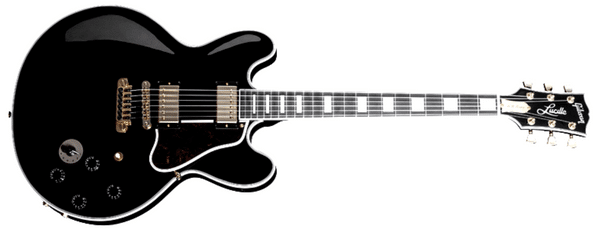
Hollow Body Guitars
Next, here are the things that define hollow body guitars.
Construction
Hollow body guitars, as the name implies, are entirely hollow. They were the first commercially available electric guitars, so they have a history rich in sound and tradition. A photo of this type of guitar appears at the bottom of this section.
The body typically has a single cutaway to reach the highest frets, but some guitars are built without a cutaway to maximize the guitar’s acoustic sound.
Unlike the semi-hollow bodies, they have no center wood clock block. These guitars have one large inner chamber with some wood bracing, making them more delicate to handle and more susceptible to damage. This also makes them more prone to feedback.
Hollow body guitars usually have f-holes on both sides to let the sound out. The bridge is not screwed onto the guitar’s body, and it has a “floating” tailpiece.
Sound
Because hollow body guitars are larger than semi-hollow body guitars, they are more acoustic-sounding and resonant with a richer, more mellow tone and are known for their “bassy” low-end.
Their lack of a center block gives them less sustain than semi-hollow body guitars.
These guitars are favorites among Jazz guitar players and some Blues players.
Still, famous country-pop player Chet Atkins preferred the Gretsch 6120, and the Beatles made the Epiphone Casino thin-line hollow body legionary in Rock music.
My Favorite Hollow Body Guitar
The Ibanez Joe Pass JP 20 is definitely my favorite among the hollow-body guitars I own!
I love playing it unplugged because it has a rich acoustic sound that projects well. The guitar has a single pickup that gives you a variety of excellent Jazz tones by making small adjustments in the guitar’s volume and tone controls.
It works well with black Fender amps like the Twin and Deluxe, and I love the sound through my vintage Fender Bassman and Mesa Boogie Blue Angel!
The JP 20 has a small narrow neck that is super fast, even with the strings set at a higher action.
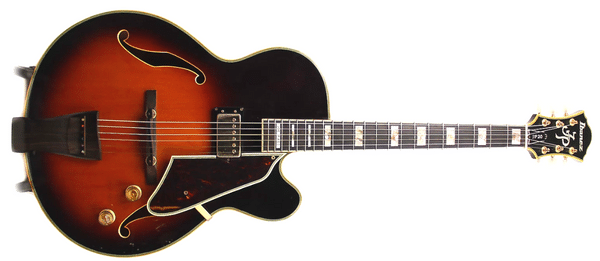
Advantages Over Solid Body Guitars

Semi-hollow body and hollow body guitars can be played acoustically without an amplifier and still give a rich sound that can project into a small audience.
Solid-body guitars require piezo pickups to take advantage of their acoustic sound.
My Parker Fly Deluxe and Parker Fly Concert are the only two solid body guitars I own that can compete with some of my semi-hollow body guitars, but they don’t come close to the richness of my hollow body guitars like the JP 20 (discussed above).
Semi-hollow and hollow body guitars can be lighter than solid bodies, but not always. My Les Pauls are heavier than any other type of guitar I own.
Once you play a good semi-hollow or hollow body guitar, you’ll realize that they are in a class all by themselves and are not a substitute for any electric solid body! If you want to play the widest range of musical genres, either get a semi-hollow body guitar or a hollow body along with a solid body.
Problems With Semi-Hollow Body And Hollow Body Guitars

Although semi-hollow and hollow body guitars are fantastic instruments, there are a few things to consider before you take the financial plunge.
These guitars have less structural stability than solid bodies, especially some hollow bodies. They are safest when stored and transported in a hard shell case. Don’t leave them lying around in your bedroom or music room. If they fall, they could get seriously damaged!
Semi-hollow and hollow body guitars are more sensitive to changes in temperature and humidity than solid body electrics. If you live in a humid or dry area, it’s essential to keep them in a controlled environment and monitor them closely!
See, How Guitar Cracks Affect The Sound – Why It Really Matters! for more info.
They may require frequent truss rod adjustments. Take your guitar to a certified guitar tech if you don’t have the proper tools or training, to avoid permanent damage to your guitar neck.
Semi-Hollow & Hollow Body Vs. Acoustic Guitars
Hollow body guitars evolved from acoustic steel string guitars. Semi-hollow body guitars were the next logical step.
Acoustic guitars typically project more sound than semi and hollow bodies because they have a larger round sound hole instead of smaller f-holes. However, some modern acoustics, like Ovation guitars, have sound hole variations.
This allows acoustic guitars to project a fuller sound farther than semi and hollow body guitars that are played unplugged.
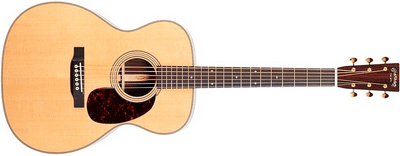
There Are Exceptions To Every Rule!
Although semi-hollow body and hollow body guitars are not typically considered “rock machines,” there are notable exceptions to every rule!
Ted Nugent
Ted Nugent, the “Motor City Madman,” and one of my favorite rock guitar players, uses a hollow body Gibson Brydland as his preferred weapon of mass sonic destruction!
The Brydland first made its appearance in 1955. It was meant to be a thinner version of the Gibson L-5CES (cutaway electric Spanish) model with a shorter scale and a narrower neck.
It gives Ted the power and feedback that he craves. Hey, why the hell isn’t Ted in the Rock And Roll Hall Of Fame yet? Perhaps a topic for another time, but that’s definitely not right!
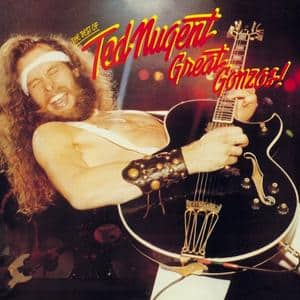
Chuck Berry
Chuck Berry’s name is synonymous with early Rock, and some players consider him the father of Rock And Roll guitar!
During his career, he used a variety of hollow and semi-hollow body guitars.
Chuck was also known for using an ES-350T in the late ’50s, which was Gibson’s version of a cheaper Byrdland with less expensive hardware and detailing.
However, he is best known for playing his iconic semi-hollow body cherry red Gibson ES-355.
It’s hard to think of Chuck without envisioning him doing his famous “duck walk” across the stage!
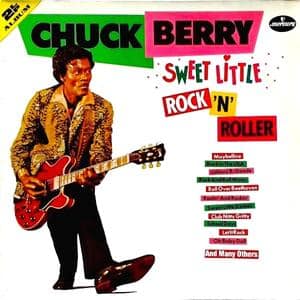
Billy Duffy
Billy Duffy is the driving force behind the Alternative Rock/Punk sounds of The Cult. His distinctive sound began with “Spiritwalker,” The Cult’s debut single.
He is well known for playing his hollow body signature Gretsch White Falcon guitar through a wall of Marshall, Orange, and Vox amps.
During the COVID lockdown, Billy worked on a series of new tunes for The Cult.
Take a listen and you’ll be amazed at what he can do with a hollow body guitar!
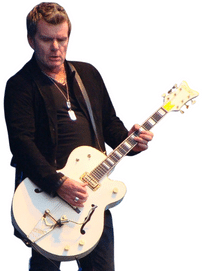
Can You Play Metal On A Semi-Hollow Or Hollow Body Guitar?
The answer is yes, but it’s certainly not the optimal approach. Most metal players use solid body guitars like Les Pauls or Super Strats.
Related Article ➡ Super Strat Guitars – Turn Your Strat Into A Shred Machine!
Uncontrolled, runaway feedback is the biggest problem with the semi-hollow, and especially the hollow body guitars played with high gain and distortion.
The easiest and most cost-effect way to control the feedback is to stuff rags inside the guitar, which players like Billy Duffy have done with good effect.
The problem with filling the cavities of these guitars with sound-dampening material is that it changes the acoustic profile of the instrument.
These days, the best way to control the feedback is by using a noise gait pedal, which will work on any type of guitar.
Frequently Asked Questions

Here are some of the questions I get asked about semi-hollow and hollow body guitars.
If your question does not appear here, please put it in the comments, and I will get right back to you with an answer.
Can Semi-Hollow And Hollow Body Guitars Be Played Acoustically?
Yes, these instruments can be played unplugged or mic’ed into the house PA system to showcase their acoustic sound. I like to play them unplugged and plugged into my favorite amps.
Are Semi-Hollow And Hollow Body Guitars Better Than Solid Body Guitars?
No, all types of guitars have their strengths and weaknesses. The type of guitar that players buy is more likely to be related to the music they play.
Semi-hollow guitars are typically considered the most versatile for any music. In contrast, hollow body guitars excel at Jazz sounds, and solid body guitars are great for loud or distorted “electric” sounds like Rock, Metal, and Country.
Can Semi-Hollow And Hollow Body Guitars Play Rock Music?
Yes, as illustrated above, players like Ted Nugent have created quintessential Rock sounds with non-solid body guitars. Ted uses a Gibson Byrdland guitar to harness feedback to his benefit and makes it musical.
Do Hollow Body Guitars Have Less Sustain?
Yes, hollow body guitars have less sustain than semi-hollow body guitars, which in turn have less sustain than solid body guitars.
Generally speaking, the more high-density wood a guitar has, the more sustain it is likely to have.
Do Hollow Body Guitars Need Amps?
No, if you are playing for yourself or a small audience, you can play both hollow and semi-hollow body guitars without an amplifier, which is what makes them so versatile.
Hearing them in a large, noisy room or outdoors may be difficult without amplification.
Final Thoughts

In the semi hollow body vs hollow body guitar debate, there are no absolute right or wrong answers, but certain concepts do hold true.
If you’re looking for a smaller-size guitar that’s more feedback friendly and capable of playing a wide variety of musical genres, then a semi-hollow body guitar might be your best bet.
On the other hand, if you want to maximize acoustic tone and play Jazz tunes or various types of mellow music, you might want to get yourself a hollow body guitar.
The best approach is to play both types of instruments and decide which one best fits your playing style and budget. Also, don’t forget to consider an all-acoustic guitar as a possible alternative.
To play Rock or Metal on a semi-hollow or hollow body guitar takes a bit of experimentation and noise suppression technology. Anything is possible if you want it bad enough, and it may be the answer to helping you develop your unique musical style.
You may well find yourself owning multiple guitars but start with a guitar that does the most for your playing style.
Here’s a great video from Andy at Reverb dot com that demonstrates the differences between hollow body, semi-hollow body, and chambered guitars. Check it out!

Tell Me What You Think

Please leave a comment below if you enjoyed this article, have any questions about semi-hollow or hollow body guitars, or want to give your point of view. I will be happy to help you.
- Do you or have you owned a semi-hollow or hollow body guitar? Which one?
- Which type of guitar do you think is the most versatile overall?
- After reading this article, are you likely to get a semi-hollow or hollow body guitar?
- What else is on your mind?

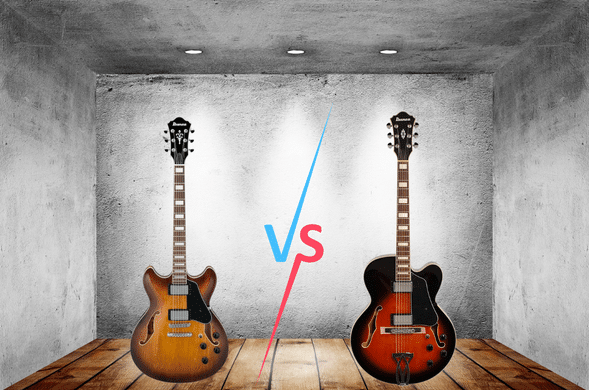

Wow! What a great article and I have learned so much by this about the different types of guitars. I did not know the body had such a huge effect in the way it performs. It’s amazing how much it benefits to do your research first before you consider buying! I look forward to reading more articles from you and I will definitely be sharing this informative article! Thank you so much.
Hi, Jasmin
Thank You for your comments!
Yes, it’s best to do your research before buying any musical instrument. It’s also a good idea to try several types of guitars before you make your choice.
If you don’t play an instrument, you should definitely choose one and give it a go! The guitar is a great instrument to start on. It’s portable, and they are available in a reasonable price range. Playing music will make every day so much better!
Take Care,
Frank 🎸
Hey hey Frank! Glad you blog about musical instruments, guitars to be exact. You certainly know your guitars well and you covered them here in complete details. I have musical background stem all the way back to the early 80’s in the height of the soul music.
However, guitars were not my instrument of choice but rather, keyboard and drum. Apparently, due to my love of music, I had bought three acoustic guitars that I occasionally played at home along with my keyboard.
You have done a marvelous job of covering guitars and I can only imagine how great you are playing guitar. Very impressive!
Hi, Vai
Thank You for your comments and compliment!
That’s great! You are a multi-instrumentalist!
I really love soul music. Back in the 1970s, I played in a local soul band, and it was a blast!
Keep on playing the guitar, keyboard, and drums!
Best,
Frank 🎸